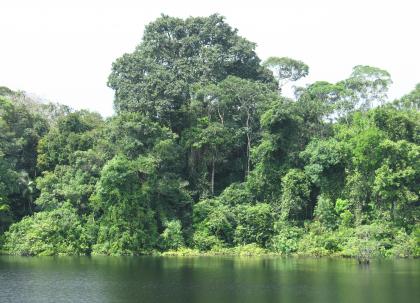Blog #7: Why is Amazonia so Diverse?
One of the strongest draws that the Amazon basin has for scientists is that it harbors the highest species diversity for many groups of organisms. Birds are no exception. There are some 700 bird species regularly occurring in all of North America, but at a single site in Amazonia, one could see as many as 400 species.
How did all this diversity evolve? There are basically two sets of explanations, ecological and evolutionary. Ecological mechanisms involve the incredibly wide range of opportunities or niches available because of the complexity of Amazonian forest. For birds, the 30-40-meter-tall forests are home to species that travel in flocks in the canopy, while different species form flocks in the mid-story or understory, or make their living on the forest floor (see above photo.)
There is also specialization: some species specialize on following ant swarms (see Photo #1 below), others specialize on vine tangles, and some specialize on bamboo or many other types of food sources. It's clear that Amazonian forests have many specialized niches that species have evolved to use.
Our work focuses on the evolutionary story behind this diversity. Despite the writings of some to the contrary, I believe that evolutionary and ecological mechanisms are entirely intertwined. But only with the development of modern tools that allow us to gather genetic data have we really begun to appreciate the evolutionary component.
Genetic data allows us for the first time to quantify the evolutionary differentiation between (and within) species, and the results strongly suggest a substantial role for evolutionary time and geographic space in shaping the high diversity. In other words, DNA sequencing tells us that Amazonian plants and animals have had a long time to diversify and specialize within a wide range of niches across the region.
Fossil data for Amazonia has generally been lacking because humid, tropical areas tend not to be good places for fossil preservation. This is further complicated by the fact that the Amazon Basin contains a massive deposit of sediments that have flowed into the basin following the formation of today's riverway drainage system, which dates to the rise of the Andes beginning 20 million years ago.
Evidence now exists in the form of fossil pollen deposits that reveal tropical tree species in the region dating back to the Miocene, 30 million years ago. For birds, the new genetic data that we're gathering doesn't show that all Amazonian species are that old, but many of the major lineages for the most diverse groups like flycatchers and antbirds actually do date back that far.
Before the advent of genetic data, the great avian biogeographer Jurgen Haffer and others had suggested Amazonian species formed during climate changes in the Pleistocene (the last 180,000 years). However, the genetic data suggest that most species are actually several million years old, which is much older than many species from higher latitudes like North America. The long timeframes available to Amazonian lineages have played a significant role in the evolution of the high diversity here.
We strongly believe that our studies also illustrate a primary role of geographic space as well. For example, although the Amazonian wilderness blankets a region that is larger than the continental United States, species lists from the eastern and western edges (or the northern and southern edges) of Amazonia would appear to match closely. Our research shows that looks can be deceiving—populations that are part of a single species with similar physical traits are often genetically differentiated into multiple lineages (see Photo #2 below.)
Within numerous species distributed across the Amazon, we found genetic divergences that are greater than that seen between species of North American birds like the genus Zonotrichia, which comprises species that include White-throated, White-crowned, and Golden-crowned Sparrows. A widespread Amazonian species may have as many as nine different distinct evolutionary lineages that the molecular data suggest may be 1-3 million years old!
So when I think now about how the great diversity of species came to exist in Amazonia, I think we still have a lot to learn, but I think a lot of research will entail understanding interactions between ecological and evolutionary forces that have worked in concert to create so many species.
More soon,
John






